

Francesco Allegrini belonged to a family of artists from Cantiano, near Gubbio, which included his father, Flaminio and his sister Anna Angelica. Since his father was in Rome at the time of is birth, he was probably born there. He seems to have trained under Giuseppe Cesari, il Cavalier d’ Arpino in ca. 1638-40 and subsequently under Pietro da Cortona. He then established his career in Rome was enrolled in the Accademia di San Luca in 1655.
His first stay in Gubbio was in the period 1652-5, when he enjoyed the patronage of Bishop Alessandro Sperelli. He returned to Gubbio in ca. 1661 and spent the greater part of the rest of his life there, returning to Rome shortly before his death.
Gubbio
Frescoes (1652-4)
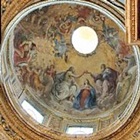
-
✴the Coronation of the Virgin, in the cupola;
-
✴the bishop saints of Gubbio (SS Ubaldus, Peter Damian, Rodolfus and John of Lodi), in the pendentives;
-
✴two scenes on the back wall;
-
•the transport of the house of the Virgin to Loreto; and
-
• the Annunciation;
-
✴Bishop Sperelli’s consecration of the church, in the lunette on the left wall; and
-
✴the translation of the relics of St John of Lodi, in the lunette on the right wall.
Martyrdom of St Constantius (ca. 1652-4)
The Barzi family of Perugia commissioned this altarpiece from Francesco Allegrini for their altar on the left wall of San Filippo Neri. It depicts the martyrdom of this patron saint of Perugia.
Saints (ca. 1654)
The frescoes above and to the sides of the altarpiece in the 1st chapel on the right of in San Pietro, which are by/attributed to Francesco Allegrini, depict:
-
✴St Ubaldus holding a model of Gubbio (to the left); and
-
✴an unidentified bishop saint.
[Also SS Francis of Paola and Philip Neri; unidentified saints, one male and one female - where ??]
St Michael (ca. 1655)
This altarpiece in San Pietro (in the 3rd bay on the left ) is by/attributed to Francesco Allegrini.
Vision of St Antony of Padua (ca. 1655)
This altarpiece in San Francesco (on the altar in the 6th bay on the left) is attributed to Francesco Allegrini.
Miracle at San Domenico in Soriano (ca. 1655)
This altarpiece in San Domenico (on the 5th altar on the right) is attributed to Francesco Allegrini. It depicts a miracle that occurred in 1530 at the sanctuary of San Domenico at Soriano in Calabria, when the Virgin and SS Mary Magdalene and Catherine of Alexandria appeared to one of the brothers and gave him an image of St Dominic. This representation also includes the Dominican SS Hyacinth, Louis Bertrand and Pius (Pope Pius V).
Annunciation (1655)
These altarpiece in the Chiesa della Misericordia [where ?] is by/attributed to Francesco Allegrini
Martyrdom of St Ursula (ca. 1655-7)
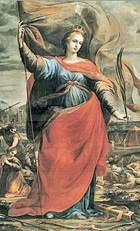
Frescoes (ca. 1661)
These frescoes in the Chiesa della Misericordia [where ?], which are by/attributed to Francesco Allegrini, depict:
-
✴SS Ubaldus and John the Baptist;
-
✴the Trinity; and
-
✴the Cardinal Virtues (Faith, Hope and Charity) [in the ceiling].
Frescoes (ca. 1661)
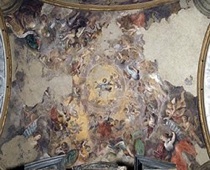
These frescoes depicting paradise, which are attributed to Francesco Allegrini, are in the vaults of the apse of Santa Maria dei Laici.
Pentecost (1665)
This altarpiece in Santa Maria della Piaggiola (on the 3rd altar on the left) is attributed to Francesco Allegrini.
St Laurence (ca. 1665)
This small panel in Sant’ Agostino (above the main altarpiece on the altar of the 3rd altar on the right) is attributed to Francesco Allegrini.
Immaculate Conception (ca. 1666)
This altarpiece in the Museo Diocesano, which is attributed to Francesco Allegrini, is of unknown provenance. [San Marziale ??]
Madonna and Child with Saints (1668)
This altarpiece in Santa Croce della Foce (on the 2nd altar on the right) is attributed to Francesco Allegrini. It depicts the Madonna and Child seated on a cloud with SS Sebastian, Ubaldus, Cosmos, Damian, Apollonia, Agatha and Ursula. The inscription on the quiver of St Sebastian names the commissioners of the work, Giovanni Carbonara and Giovanni Paolo Gamboccio, priors of the Confraternita di Santa Croce della Foce, and gives the date.
Blessed Villanus (ca. 1670)
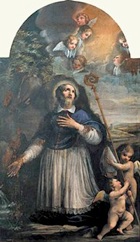
St Sebastian (1673 ?)
This panel in the Museo Diocesano, which is by/attributed to Francesco Allegrini, is of unknown provenance.
Work in Santa Maria del Prato (1674-8)
Bishop Alessandro Sperelli commissioned the frescoes of the large oval vault of Santa Maria del Prato from Francesco Allegrini in 1669. However, work seems to have been delayed by a shortage of funds. The work probably finally began in 1677, and Allegrini was paid for it in the following year:
-
✴The fresco in the vault depicts the Glory of Paradise, with the Holt Spirit at the centre and God the Father and Christ (the other two figures of the Trinity) above the altar wall.
-
✴The fresco in the semi-dome below depicts the Virgin ascending towards them.
-
✴The frescoes in the pendentives were probably part of this commission:
-
•those of of Faith, Humility and Charity are attributed to Francesco Allegrini; and
-
•that of Hope is attributed to Louis Dorigny, who was described in the 19th century as “il Giovane del Signor Alegrini” (the young assistant of Francesco Allegrini).
An inscription on the Altare di Santo Stefano on the left records that Paolo Emilio Galeotti dedicated it to St Stephen in 1674. The decoration, which is attributed to Francesco Allegrini and which was probably executed at the time that the altar was dedicated, comprises:
-
✴the altarpiece of the martyrdom of St Stephen; and
-
✴the fresco of the same subject in the small vault above.
Madonna and Child with St Trophimus (1677)
This altarpiece in Santa Croce della Foce [where ?] depicts the Madonna and Child seated on a cloud. St Trophimus of Arles below begs them to cure people suffering from gout. It is probably “il quadro di San Trofimo” for which Agostino Steuchi, the Prior of the Confraternita di Santa Croce della Foce paid “il Francese” (probably Louis Dorigny) in 1677. It might have been executed in collaboration with Francesco Allegrini.
Gualdo Tadino
Madonna and Child with saints (ca. 1668)
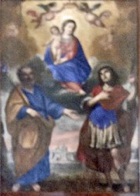
Panels (17th century)
These panels in the Pinacoteca, which are attributed to Francesco Allegrini, probably came from Palazzo Comunale. They depict:
-
✴the Judgement of Solomon; and
-
✴Lot and his Daughters.
Perugia
Marsyas’ Challenge to Apollo (17th century)
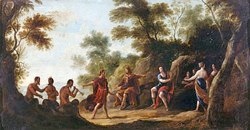
The collection of the Collection of the Fondazione Cassa di Risparmio di Perugia contains two panels that are attributed to Francesco Allegrini. They depict:
-
✴the taking of auguries that led to the foundation of Rome by Romulus and Remus; and
-
✴the satyr Marsyas challenging Apollo to a musical contest, a presumption that will lead to his flaying and death (illustrated here).
Read more:
M. Nocella, “Flaminio e Francesco Allegrini: Novità Documentarie e Aggiunte al Corpus delle Opere”, (2007) Città di Castello
Return to Art in: Gualdo Tadino Gubbio Perugia.

